International Map of the World sheet Istmo de Tehuantepec (1938)
American Geographical Society
Public Domain: copyright not renewed
|
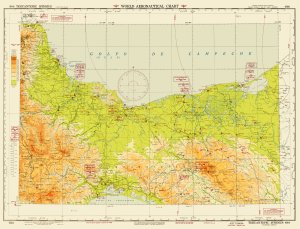 |
World Aeronautical Chart sheet Tehuantepec Isthmus (1946) |
| |
US Aeronautical Chart Service
Public Domain: US government |
|
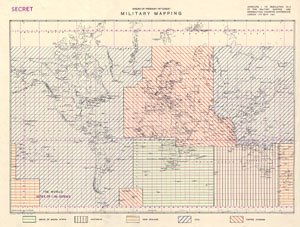

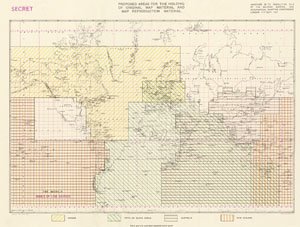
| FIGURE 2.12 |
| The division of Allied mapping responsibility in 1947: military-topographic maps, aeronautical charts, and storage of reproduction material |
Directorate of Military Survey
Copyright 1947 |
|
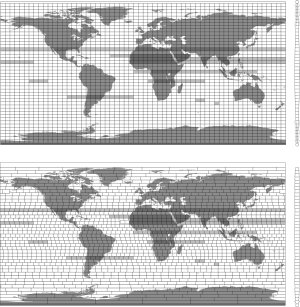
| FIGURE 2.13 |
| Comparison of sheet grids for the International Map of the World and the World Aeronautical Chart |
William Rankin
Creative Commons BY-NC-SA |
|
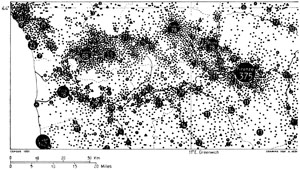

| FIGURE 2.14 |
| World Population Maps of Tuscany (top) and Ventura County, California (bottom) |
Geografiska Annaler
Copyright 1963 |
|
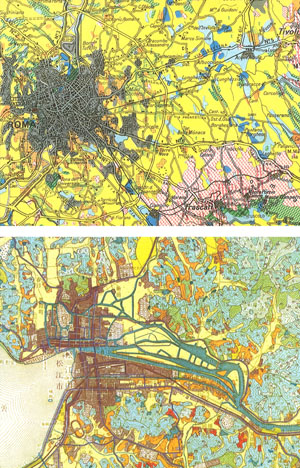
| FIGURE 2.15 |
| Comparison of World Land-Use Survey maps from central Italy (top) and western Japan (bottom) |
Internationales Jahrbuch für Kartographie
Copyright 1968 |
|
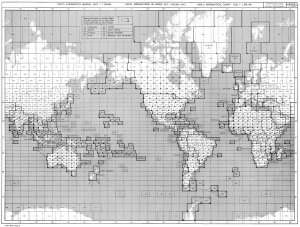
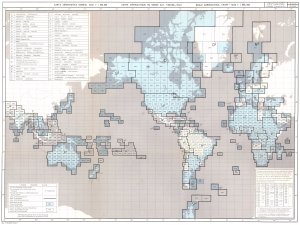 |
FIGURE 2.16 |
| Sheet index for the International World Aeronautical Chart: March and October 1962
|
International Civil Aviation Organization
Public Domain: UN publication |
|
 |
FIGURE 2.17 |
| Design alternatives for the World Aeronautical Chart tested for the US Office of Naval Research in 1952
|
from John E. Murray and Rolland H. Waters, “The Design of Aeronautical Charts II,” Navigation (US) 3 (Dec 1952), 193
Public Domain: copyright not renewed |
|
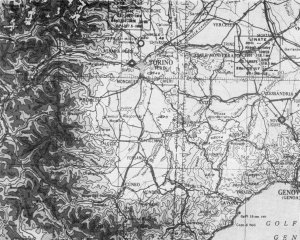
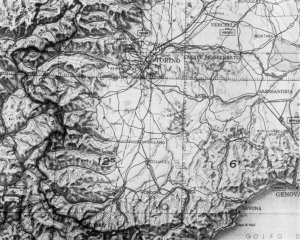 |
FIGURE 2.18 |
| Comparison of the design of American World Aeronautical Charts in 1948 and 1957 (both maps show the same area in northern Italy) |
from Richard W. Philbrick, “New Design Features for the World Aeronautical Chart,” Surveying and Mapping (July–Sept 1957), 303, 306
Public Domain: copyright not renewed |
|

| FIGURE 2.19 |
| The place of the International World Aeronautical Chart in the official specifications of the International Civil Aviation Organization, 1949−2001 |
William Rankin
Creative Commons BY-NC-SA |
|

| FIGURE 3.1 |
| One-kilometer artillery grid on a French trench map, Moreuil, 5 Aug 1918 |
Service Géographique de l’Armée
Public Domain: copyright expired |
|

| FIGURE 3.2 |
| Universal Transverse Mercator grid on a US topographic map, Solomons Island, 1987 |
US Geological Survey
Public Domain: US government |
|
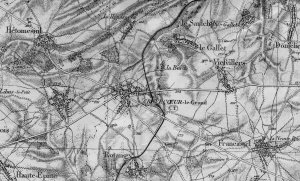
| FIGURE 3.3 |
| Detail from the French carte de l’État major, 1885 |
Dépôt de la Guerre
Public Domain: copyright expired |
|
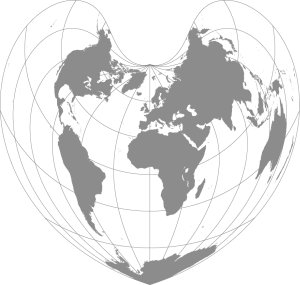
| FIGURE 3.4 |
| The Bonne projection used for the carte de l’État major, extended to show the entire world |
William Rankin
Creative Commons BY-NC-SA |
|
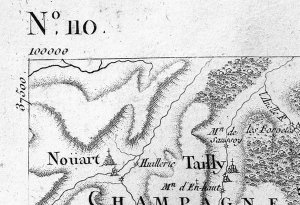
| FIGURE 3.5 |
| Sheet corner from Cassini's Carte de France, Verdun, 1760 |
César-François Cassini de Thury
Public Domain: copyright expired |
|
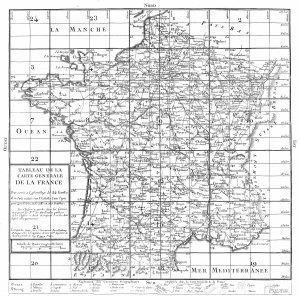
| FIGURE 3.6 |
| Index sheet from Cassini's Carte de France, 1797 |
César-François Cassini de Thury
Public Domain: copyright expired |
|
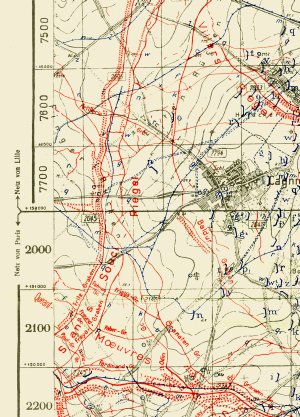
| FIGURE 3.7 |
| Grid junctions on a German trench Map, Bourlon, 18 Sep 1918 |
reproduced in Oskar Albrecht, Das Kriegsvermessungswesen während des Weltkrieges 1914–18 (München: Bayerische Akademie der Wissenschaften, 1969)
Public Domain: copyright expired |
|
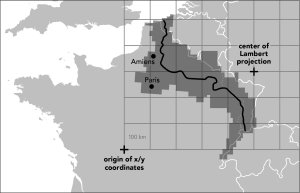
| FIGURE 3.8 |
| Deployment of the French système Lambert map grid along the western front |
William Rankin
Creative Commons BY-NC-SA |
|

| FIGURE 3.9 |
| The Lambert projection used for the système Lambert, extended to show the entire world |
William Rankin
Creative Commons BY-NC-SA |
|
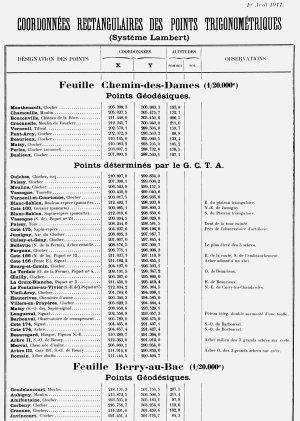
| FIGURE 3.10 |
| Page from a French trig list, April 1917, giving grid coordinates |
Service Géographique de l’Armée; reproduced in Peter Chasseaud, Artillery’s Astrologers: A History of British Survey & Mapping on the Western Front, 1914–1918 (Lewes: Mapbooks, 1999), 514
Public Domain: copyright expired |
|
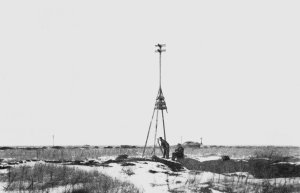
| FIGURE 3.11 |
| British surveyors measuring a captured German trig beacon during World War I |
from H. Winterbotham, “Geographical Work with the Army in France,” The Geographical Journal 54 (July 1919), 13
Public Domain: copyright expired |
|
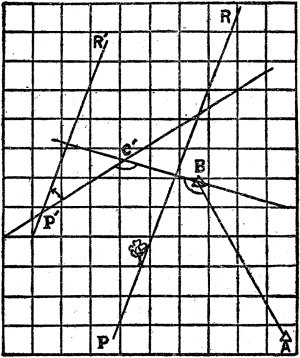
| FIGURE 3.12 |
| Textbook demonstration of how to plot a target on a plotting board |
from Manual for the Artillery Orientation Officer [translated from French original] (Washington DC: USGPO, 1917), 100
Public Domain: copyright expired |
|
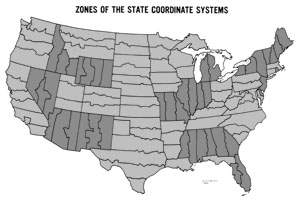
| FIGURE 3.13 |
| Zones of the US State Plane Coordinate System, with a separate grid system for each zone |
Surveying and Mapping
Copyright 1967 |
|
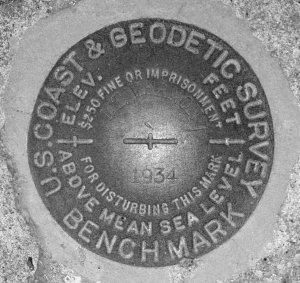
| FIGURE 3.14 |
| Survey monument in Mt. Vernon, Texas, placed in 1934 |
QuesterMark
Creative Commons BY-SA |
|
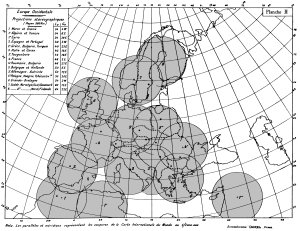
| FIGURE 3.15 |
| Henri Roussilhe’s scheme for an international grid system, 1922 |
from H. Roussilhe, “Emploi des coordonnées rectangulaires stéréographiques pour le calcul de la triangulation dans un rayon de 560 kilomètres autour de l’origine,” Travaux de l’Association internationale de géodésie 1 (Paris, 1923 [presented 1922]); shading added
Public Domain: copyright expired |
|
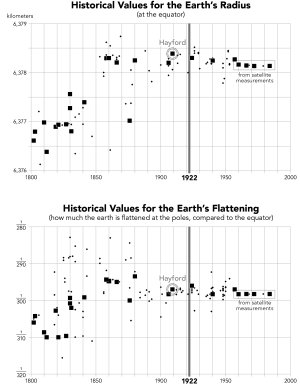
| FIGURE 3.16 |
Historical values for the size and shape of the earth
download data in a spreadsheet |
William Rankin
Creative Commons BY-NC-SA |
|

| FIGURE 3.17 |
| The junction of the French and Belgian national triangulations as of 1920 |
William Rankin
Creative Commons BY-NC-SA |
|
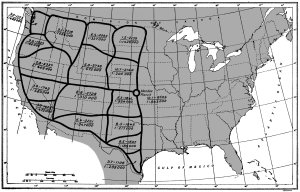
| FIGURE 3.18 |
| The use of computationally efficient “Bowie Loops” in the western United States |
from Oscar Adams, The Bowie Method of Triangulation Adjustment, US Coast and Geodetic Survey special publication 159 (Washington, DC: USGPO, 1930), 10; shading added
Public Domain: US government |
|
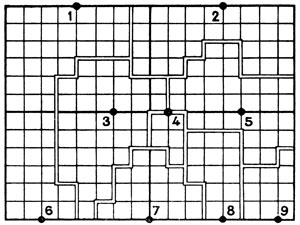
| FIGURE 3.19 |
| Schematic plan for the recalculation of the European triangulation network, 1939 |
Bulletin géodésique
Copyright 1939 |
|

| FIGURE 3.20 |
| Pierre Tardi's plan for a grid system for Africa, 1936 |
Bulletin géodésique
Copyright 1938 |
|
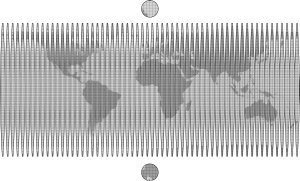
| FIGURE 4.1 |
The Universal Transverse Mercator grid system, shown as if all maps were laid together like an unfolded globe
download grid as a GIS layer |
William Rankin
Creative Commons BY-NC-SA |
|

| FIGURE 4.2 |
| Use of the Universal Transverse Mercator grid (and its Soviet counterpart) by the end of the Cold War |
William Rankin
Creative Commons BY-NC-SA |
|

| FIGURES 4.3 AND 4.4 |
| British and American grids during World War II |
from US Army Map Service Memorandum No. 425, Grids and Magnetic Declinations, 2nd ed. (Washington DC, 1943); shading added
Public Domain: US government |
|
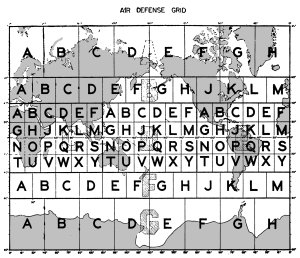
| FIGURE 4.5 |
| The first two reference levels of the US Air Defense Grid |
from War Department Technical Manual TM 44-225, Orientation for Artillery (Washington DC, 1944); shading added
Public Domain: US government |
|
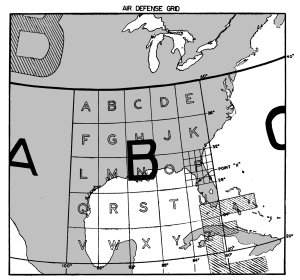
| FIGURE 4.6 |
| The most precise references on the US Air Defense Grid |
from War Department Technical Manual TM 44-225, Orientation for Artillery (Washington DC, 1944); shading added
Public Domain: US government |
|
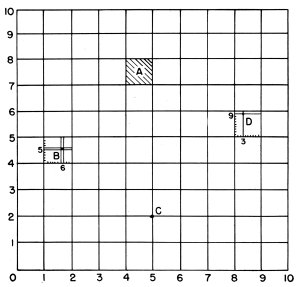
| FIGURE 4.7 |
| The US Joint Army–Navy reference system, applied to individual map sheets |
from War Department Technical Manual TM 44-225, Orientation for Artillery (Washington DC, 1944); shading added
Public Domain: US government |
|

| FIGURE 4.8 |
| Expansion of the US Joint Army–Navy system to adjacent sheets (original map is square M) |
from War Department Technical Manual TM 44-225, Orientation for Artillery (Washington DC, 1944); shading added
Public Domain: US government |
|
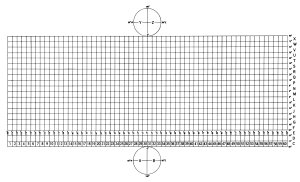
| FIGURE 4.9 |
| Top-level “Grid Zone Designations” for the Universal Transverse Mercator grid |
from US Army Map Service Technical Manual No. 36, Grids and Grid References (Washington DC, 1950)
Public Domain: US government |
|

| FIGURE 4.10 |
| Grid Zones subdivided into 100-kilometer squares |
from US Army Map Service Technical Manual No. 36, Grids and Grid References (Washington DC, 1950)
Public Domain: US government |
|

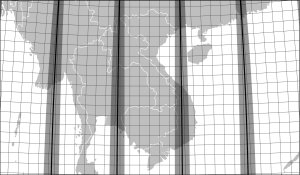
| FIGURE 4.11 |
Areas of the Universal Transverse Mercator grid with high errors (in dark gray) for Europe and Southeast Asia
download grid as a GIS layer |
William Rankin
Creative Commons BY-NC-SA |
|
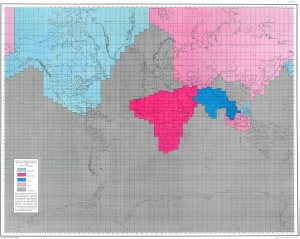
| FIGURE 4.12 |
| Ellipsoids used for the Universal Transverse Mercator grid |
from US Army Map Service Technical Manual No. 7, Universal Transverse Mercator Grid Tables (Washington DC, 1949?)
Public Domain: US government |
|
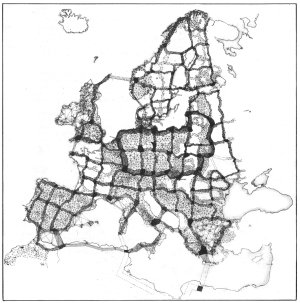
| FIGURE 4.13 |
| The US Army Map Service's scheme for recalculating the European triangulation, 1947 |
from Floyd Hough, “The Readjustment of European Triangulation,”
Transactions, American Geophysical Union 28 (Feb 1947), 63
Public Domain: copyright not renewed |
|
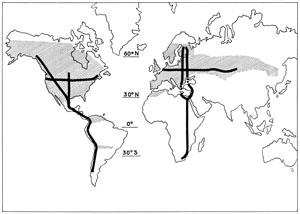
| FIGURE 4.14 |
| High-precision survey data used by the US Army Map Service to recalculate the size and shape of the earth in 1956 |
Bulletin géodésique
Copyright 1959 |
|
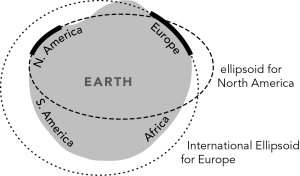
| FIGURE 4.15 |
| Mismatches between North-American and European values for the size and shape of the earth |
William Rankin, after Irene Fischer
Creative Commons BY-NC-SA |
|
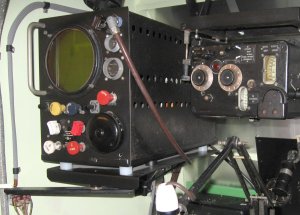
| FIGURE 5.1 |
| Mockup of a Gee receiver in an Avro Lancaster bomber |
photo by Peter Zijlstra
used with permission |
|

| FIGURE 5.2 |
| Gee lattice chart showing northern England, Wales, and eastern Ireland (postwar reprint of 1944 edition) |
British War Office
Public Domain: expired Crown Copyright |
|
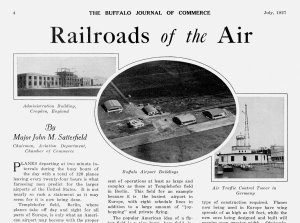
| FIGURE 5.3 |
| A call for public investment in aviation: Buffalo, NY, 1927 |
Buffalo Journal of Commerce
Public Domain: copyright not renewed |
|
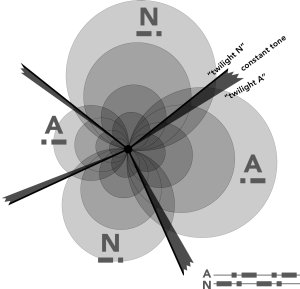
| FIGURE 5.4 |
| The directional Morse-code broadcasts of the US Radio Range create four narrow beams |
William Rankin
Creative Commons BY-NC-SA |
|
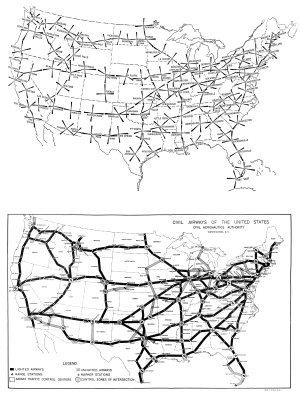
| FIGURE 5.5 |
| The network of Radio-Range airways in the United States in the late 1930s |
from Ronald Keen, Wireless Direction
Finding, 3rd ed. (London: Iliffe & Sons, 1938), 484, and Civil Aeronautics Authority, First Annual Report of the Civil Aeronautics Authority (Washington: USGPO, 1940), appendix B
Public Domain: US government |
|

| FIGURE 5.6 |
| Radio Direction Finding (D/F) stations in Europe as of 1931 |
William Rankin
Creative Commons BY-NC-SA |
|
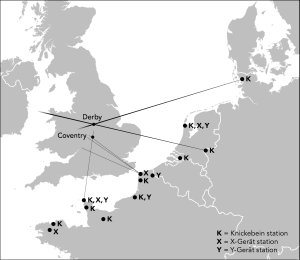
| FIGURE 5.7 |
| German beams aimed at the UK during the Battle of Britain, summer 1941 |
William Rankin
Creative Commons BY-NC-SA |
|
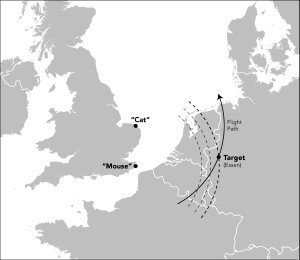
| FIGURE 5.8 |
| The British Oboe system, as configured for a bombing raid on Essen in 1942 |
William Rankin
Creative Commons BY-NC-SA |
|
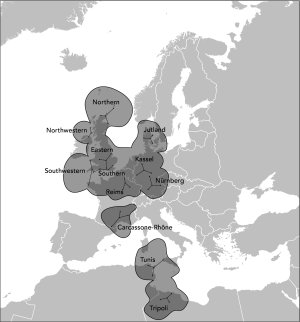
| FIGURE 5.9 |
| European coverage of the British Gee system at the end of World War II |
William Rankin
Creative Commons BY-NC-SA |
|

| FIGURE 5.10 |
| Coverage of the German Sonne system at the end of World War II |
William Rankin
Creative Commons BY-NC-SA |
|
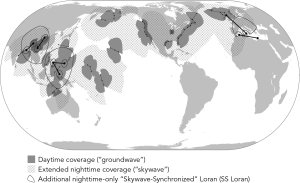
| FIGURE 5.11 |
Coverage of the American Loran system at the end of World War II
download transmitter locations and chain connections as GIS layers |
William Rankin
Creative Commons BY-NC-SA |
|
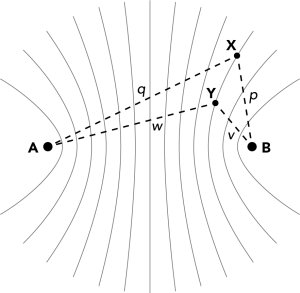
| FIGURE 5.12 |
| Hyperbolic navigation: position is determined by measuring the time difference between signals sent from two synchronized transmitters |
William Rankin
Creative Commons BY-NC-SA |
|
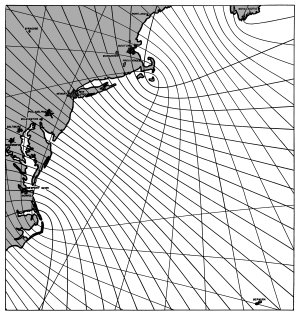
| FIGURE 5.13 |
| The hyperbolic grid of Loran off the east coast of the United States and Canada |
from J. A. Pierce, “An Introduction to Loran,” Proceedings of the IRE 34 (May 1946), 219; shading added
Public Domain: copyright not renewed |
|
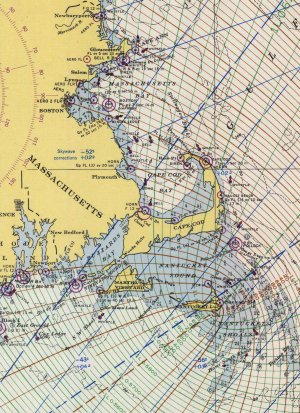
| FIGURE 5.14 |
| Detail of Loran Chart, Atlantic Coast: Cape Sable to Cape Hatteras, chart 1000-L (1948) |
US Coast and Geodetic Survey
Public Domain: US government |
|
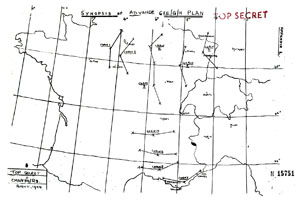
| FIGURE 5.15 |
| Plan for advancing Gee coverage in France and Germany after D-Day |
British War Office
Copyright 1944 |
|
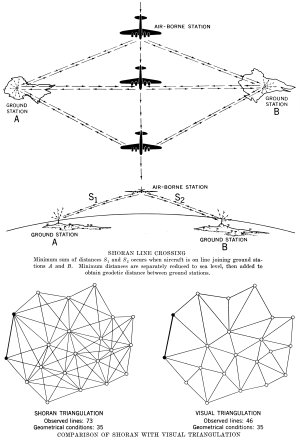
| FIGURE 5.16 |
| Trilateration surveying with Shoran after World War II |
from Carl Aslakson, “The Influence of Electronics on Surveying and Mapping,” Surveying and Mapping (July–Sept 1950), 167
Public Domain: copyright not renewed |
|
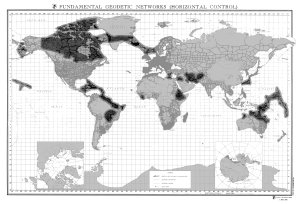
| FIGURE 5.17 |
| Trilateration performed during the 1950s and 1960s (shaded in gray) |
from Defense Mapping Agency, Geodesy for the Layman, 5th ed. (Washington: DMA, 1983; map dated 1971), 18; shading added
Public Domain: US government |
|
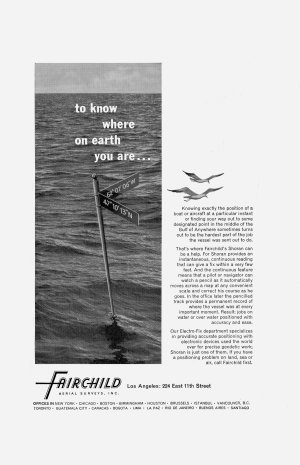
| FIGURE 5.18 |
| Advertisement for offshore radio surveying, 1959 |
from Surveying and Mapping (Mar 1959), 141
Public Domain: copyright not renewed |
|
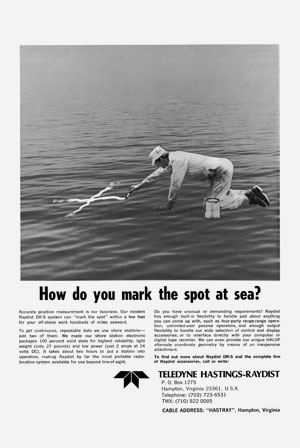
| FIGURE 5.19 |
| Advertisement for offshore radio surveying, 1971 |
Surveying and Mapping
Copyright 1971 |
|
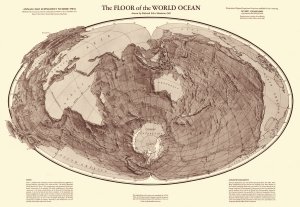
| FIGURE 5.20 |
| The Floor of the World Ocean, by Richard Edes Harrison (1961 version of 1959 original) |
from Annals of the Association of
American Geographers 51 (Sept 1961)
Public Domain: copyright not renewed |
|
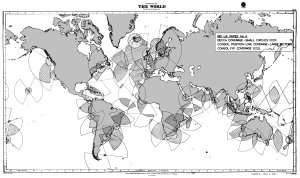
| FIGURE 5.21 |
| British proposal for worldwide Consol and Decca coverage, 1947 |
from International Meeting on Marine Radio Aids to Navigation: Proceedings and Related Documents, April 28 –
May 9, 1947 (Washington: State Department, 1948), facing 438; shading added
Public Domain: US government |
|

| FIGURE 5.22 |
| 1959 US plan for the VOR/DME airway network through 1965 |
from US Air Coordinating Committee Technical Division, “Short Distance Radionavigation: Background Information and Views Presented by the United States of America,” 1958 (ICAO, box “SP/COM/OPS/RAC 1958”), chart 9
Public Domain: US government |
|
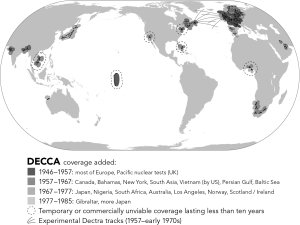
| FIGURE 5.23 |
Expansion of Decca coverage, 1946–1985
download transmitter locations and chain connections as GIS layers |
William Rankin
Creative Commons BY-NC-SA |
|
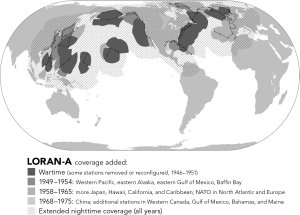
| FIGURE 5.24 |
Expansion of Loran-A coverage, 1946–1975
download transmitter locations and chain connections as GIS layers |
William Rankin
Creative Commons BY-NC-SA |
|
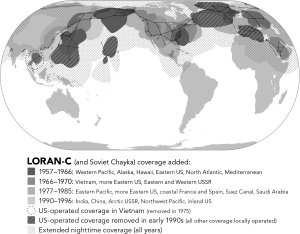
| FIGURE 5.25 |
Expansion (and contraction) of Loran-C coverage, 1957–1996
download transmitter locations and chain connections as GIS layers |
William Rankin
Creative Commons BY-NC-SA |
|
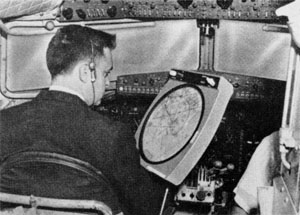
| FIGURE 5.26 |
| Integrated map display with a fixed map and a movable "bug" showing the pilot's real-time location (1965) |
Navigation (US)
Copyright 1965 |
|
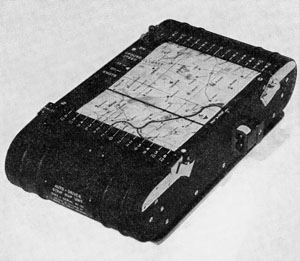
| FIGURE 5.27 |
| A palm-sized "roller map" display that would automatically advance as the plane followed its course (1960) |
Journal of the Institute of Navigation (UK)
Copyright 1960 |
|

| FIGURE 6.1 |
| GPS satellite constellation design, mid-1980s |
from R. L. Beard, J. Murray, and J. D. White, “GPS Clock Technology and the Navy PTTI Programs at the U.S. Naval Research Laboratory,” in Proceedings of the Eighteenth Annual Precise Time and Time Interval (PTTI) Applications and Planning Meeting (1986), 50
Public Domain: US government |
|

| FIGURE 6.2 |
| A GPS collar on “Floggy,” a brown hyena, in Namibia in 2006 |
photo by Ingrid Wiesel, from “Predicting the influence of land development on brown hyena (Parahyaena brunnea) movement and activity”
used with permission |
|
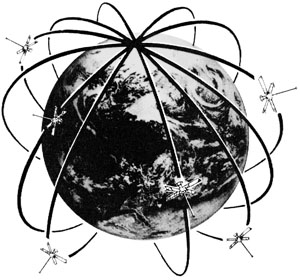
| FIGURE 6.3 |
| The "birdcage" of the US Navy's Transit satellites |
Navigation (US)
Copyright 1978 |
|
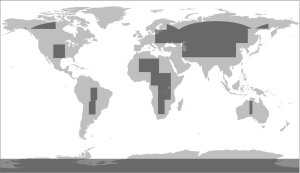
| FIGURE 6.4 |
| Coverage of Omega lattice charts in the early 1970s: maps were not available gray areas |
William Rankin
Creative Commons BY-NC-SA |
|
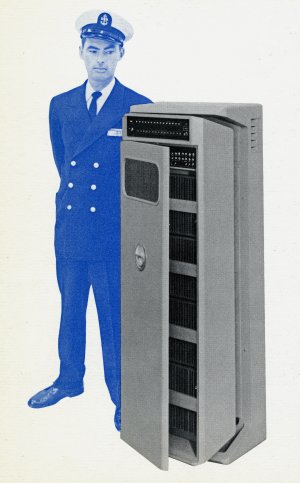
| FIGURE 6.5 |
| The US Navy's AN/UYK-1 computer for Transit satellite navigation, circa 1961 |
from Ramo-Woolridge (a division of TRW), AN/UYK-1: A Multiple Purpose Digital Computer, 21 Apr 1961
Public Domain: no copyright notice |
|
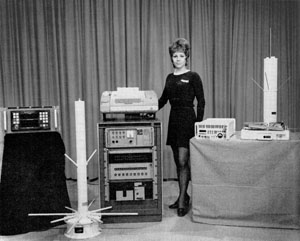
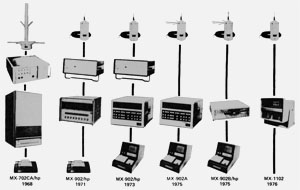
| FIGURE 6.6 |
| Shrinking Transit equipment from Magnavox, 1968 to 1976 |
Navigation (US)
Copyright 1971, 1978 |
|

| FIGURE 6.7 |
Omega transmitter locations, 1951–1997
download locations as a GIS layer |
William Rankin
Creative Commons BY-NC-SA |
|
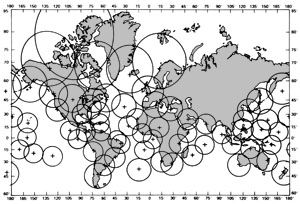
| FIGURE 6.8 |
| Proposed network of Omega monitoring stations as of 1978 |
Navigation (US)
Copyright 1978 |
|
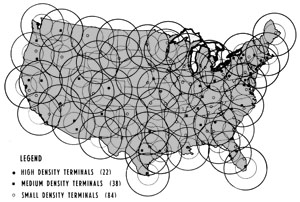
| FIGURE 6.9 |
| A 1975 proposal for “differential” Omega stations in the contiguous United States |
Navigation (US)
Copyright 1975 |
|

| FIGURE 6.10 |
| Ground installations for the Transit satellite system |
William Rankin
Creative Commons BY-NC-SA |
|

| FIGURE 6.11 |
| A civilian satellite-navigation system designed for NASA, circa 1970 |
from Leo M. Keane et al., “Global Navigation and Traffic Control Using Satellites,” NASA Technical Report R-342, July 1970,12
Public Domain: US government |
|
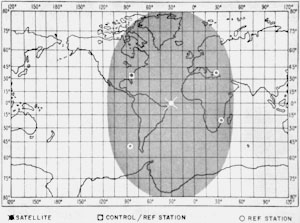
| FIGURE 6.12 |
| A plan for megaregional coverage for a civilian satellite navigation system in a geostationary orbit, mid-1960s |
Navigation (US)
Copyright 1966 |
|
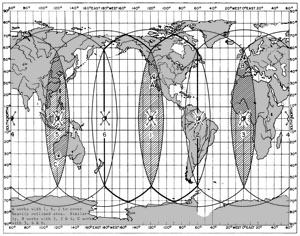
| FIGURE 6.13 |
| A plan for near-global civilian coverage from six geostationary satellites, mid-1960s |
Navigation (US)
Copyright 1967 |
|

| FIGURE 6.14 |
Launch and operational status of GPS satellites, 1978–2010
download data in a spreadsheet |
William Rankin
Creative Commons BY-NC-SA |
|

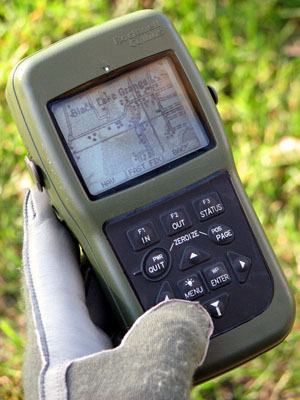
| FIGURE 6.15 |
| The shrinking size of GPS equipment: the "Manpack" of 1978 compared with the DAGR of 2004 |
from Steven Lazar, “Modernization and the Move to GPS III,” Crosslink 3 (Summer 2002), 45, and Rockwell Collins, Inc.
Copyright 1978?, 2008? |
|
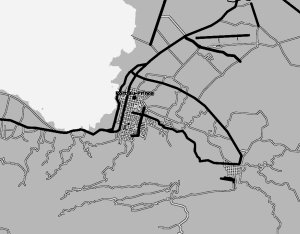

| FIGURE 6.16 |
| OpenStreetMap data, before and after the 2010 Haiti earthquake |
adapted from Mikel Maron's screencaptures
Creative Commons BY-SA |
|
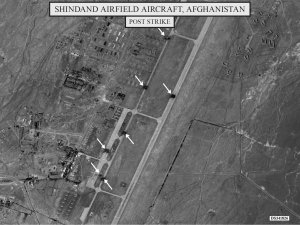
| FIGURE 6.17 |
| Shindand airfield, Afghanistan, after an American GPS-guided bomb strike, October 2001 |
US Department of Defense
Public Domain: US government |
|

| FIGURE 6.18 |
GPS augmentation systems as of 2015: Differential GPS (DGPS) and Satellite-Based Augmentation Systems (SBAS)
download DGPS as GIS layers |
William Rankin
Creative Commons BY-NC-SA |
|

| FIGURE 6.19 |
| GPS ground installations: original US-controlled sites, with more recent stations in other countries |
William Rankin
Creative Commons BY-NC-SA |
